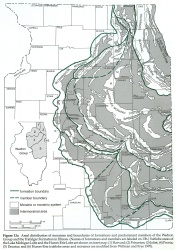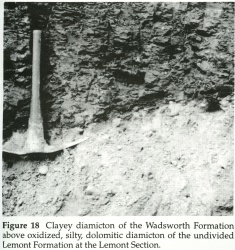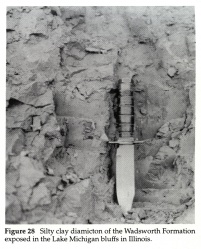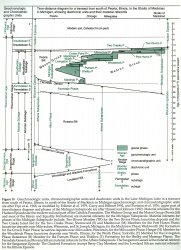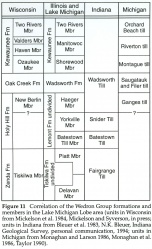Wadsworth Formation
Lithostratigraphy: Wedron Group >>Wadsworth Formation
Chronostratigraphy: Cenozoic Erathem >>Quaternary System >>Pleistocene Series
Primary source
Hansel, Ardith K., and W. Hilton Johnson, 1996, Wedron and Mason Groups: Lithostratigraphic Reclassification of Deposits of the Wisconsin Episode, Lake Michigan Lobe Area: Illinois State Geological Survey Bulletin 104, 116 p.
Contributing author(s)
Ardith K. Hansel and W. Hilton Johnson
Name
Original description
Wadsworth Till Member (Willman and Frye 1970).
Derivation
Wadsworth, a village in Lake County.
Other names
History/background
The Wadsworth Till Member of the Wedron Formation was defined by Willman and Frye (1970) and described as consisting of the clay-rich gray tills of the Valparaiso, Tinley, and Lake Border Moraines. Slight differences in texture and clay-mineral composition of Wadsworth diamicton were reported from the different moraines by Willman and Frye (1970) and Hansel (1983), but the unit was not formally subdivided. Subsurface studies also reported subunits on the basis engineering and lithological properties (Bogner 1975, Killey and Trask 1994). The Wadsworth Till Member was mapped beneath Lake Michigan in the southern part of the lake basin (Lineback et al. 1974, Wickham et al. 1978, Colman et al. 1989, Colman and Foster 1990).
The Wadsworth Till Member of the Wedron Formation (Willman and Frye 1970) is herein elevated in rank to the Wadsworth Formation of the Wedron Group. The Wadsworth Formation constitutes a distinct gray clay-rich lithostratigraphic unit that encircles the southern part of Lake Michigan and occurs beneath the southern third of the lake basin (fig. 8).
Type section
Type location
Roadcut at the intersection of Illinois Highway 131 and Wadsworth Road, 2 miles east of Wadsworth.
Type author(s)
Type status
No longer exposed.
Reference section
Reference location
Fort Sheridan Lake Bluff Section; good for lithology. Land and Lakes Landfill Section; good for lithology and lower contact. Cedarburg Lake Bluff Section in Wisconsin; good for lithology of the Wadsworth-equivalent Oak Creek Formation and upper contact.
Reference author(s)
Reference status
Stratigraphic relationships
The Wadsworth Formation of the Wedron Group is a succession of fine grained, gray diamicton units that overlies the Lemont Formation and underlies the Kewaunee Formation.
Wadsworth diamicton is generally readily distinguished from Haeger diamicton or the undivided Lemont Formation by its finer grain size (fig. 18) and conspicuous Devonian shale clasts. Conversely, it is quite similar lithologically to Yorkville diamicton of the Lemont Formation; a vertical boundary at the West Chicago-Wilton Center moraine front is used to separate these diamictons for mapping purposes (fig. 13). In the subsurface, the Yorkville Member is not differentiated from the Wadsworth Formation unless stratigraphic control is present (e. g., the Haeger Member, undivided Lemont Formation, or tongues of the Henry and Equality Formations). Diamicton of the overlying Kewaunee Formation is distinctly redder and generally lacks the shale clasts characteristic of the Wadsworth Formation. Diamicton of the Wadsworth Formation is more illitic than diamicton of the Kewaunee Formation and the Haeger Member of the Lemont Formation, although some Wadsworth diamicton is similar to or less illitic than some Yorkville diamicton (Hansel 1983, Glass and Killey 1987).
|
Extent and thickness
The Wadsworth Formation is at the surface in the Joliet Sublobe area (fig. 13). It is generally beneath the thin Equality Formation under southern Lake Michigan south of Milwaukee, Wisconsin, and Muskegan, Michigan (fig. 8). Regionally, it forms a crescent-shaped wedge that overlaps the Lemont Formation and equivalent units in Wisconsin, Indiana, and Michigan; it pinches out beneath the Kewaunee Formation in Lake Michigan and Wisconsin. The Wadsworth Formation is thickest in the end moraine ridges that encircle the southern margin of the Lake Michigan basin, where thicknesses of up to 50 meters (164 ft) are known.
Lithology
The Wadsworth Formation consists of calcareous, gray, fine textured diamicton (fig. 28) that contains lenses of sorted and stratified sediment, which is predominantly clay, silt, and fine sand. Wadsworth diamicton, generally pebbly, silty clay, contains less than 10% to 15% sand. Most diamicton beds appear relatively homogeneous and massive; some contain silt laminae and sand lenses. Dominant clast lithologies are Silurian dolomite and Devonian shale.
Core(s)
Photograph(s)
Contacts
Lower boundary: the contact with the undivided Lemont Formation (fig. 18), the Haeger or Yorkville Members (Lemont Formation), tongues of the Henry and Equality Formations, older units, or bedrock. Upper boundary: the contact with the Shorewood or Ozaukee Members of the Kewaunee Formation, upper tongues of the Peoria Silt and the Equality and Henry Formations, or postglacial units.
Well log characteristics
Fossils
Age and correlation
The Wadsworth Formation was deposited during the Crown Point Phase of the Michigan Subepisode when the Lake Michigan Lobe advanced out of the lake basin at its southern margin for the final time between about 15,500 and 13,800 radiocarbon years ago (Hansel and Johnson 1992; fig. 10). It correlates with the Oak Creek Formation of Wisconsin, the Wadsworth Till of Indiana, and the Saugatuck and Filer tills of Michigan (fig. 11).
|
Environments of deposition
The Wadsworth Formation is interpreted to represent predominantly till and sediment that underwent redeposition in an ice-marginal and/or subaqueous environment. Hummocky topography in the area of the Valparaiso Moraine suggests that resedimentation must have been important in the deposition of part of the Wadsworth Formation. Although few exposures are available in that area for sedimentological study, water-well and core samples indicate abundant lenses of fine grained sorted sediment within the unit. The topography of the Tinley and Lake Border Moraines is less hummocky and more ridge-like than that of the Valparaiso Moraine. Ice-marginal lakes were present during the formation of these moraines, and proglacial lacustrine and mass wasting processes are recorded in the glacigenic sediment sequences (Jung and Powell 1985, Clark and Rudloff 1990, Ronnert 1992).
Economic importance
Remarks
Revised unit. Elevated in rank to a formation of the Wedron Group, and name changed to the Wadsworth Formation. Formerly classified as the Wadsworth Till Member of the Wedron Formation (Willman and Frye 1970).
References
BOGNER, J. E., 1975, Pleistocene stratigraphic framework for engineering geology in the Chicago Loop— An update: Geological Society of America Abstracts with Programs, v. 7, no. 7, p. 1003-1004.
CLARK, P., and G. A. RUDLOFF, 1990, Sedimentology and stratigraphy of late Wisconsinan deposits, Lake Michigan bluffs, northern Illinois, in A. F. Schneider and G. S. Gordon, editors, Late Quaternary History of the Lake Michigan Basin: Geological Society of America Special Paper 251, p. 29-42.
COLMAN, S. M., and D. S. FOSTER, 1990, Stratigraphy, Descriptions, and Physical Properties of Sediments Cored in Lake Michigan: United States Geological Survey Open File Report 90-478, 92 p.
COLMAN, S. M., D. S. FOSTER, and R. N. OLDALE, 1989, Evidence from seismic-reflection profiles of late Wisconsinan ice readvances in the Lake Michigan basin: Geological Society of America Abstracts with Programs, v. 21, no. 4, p. 7.
GLASS, H. D., and M. M. KILLEY, 1987, Principles and applications of clay mineral composition in Quaternary stratigraphy—Examples from Illinois, in J .J. M. van der Meer, editor, Tills and Glacitectonics: A. A. Balkema, Rotterdam, p. 117-125.
HANSEL, A. K., 1983, The Wadsworth Till Member of Illinois and the equivalent Oak Creek Formation of Wisconsin, in D. M. Mickelson, and L. Clayton, editors, Late Pleistocene History of Southeastern Wisconsin: Wisconsin Geological and Natural History Survey Geoscience Wisconsin, v. 7, p. 1-16.
HANSEL, A. K., and W. H. JOHNSON, 1992, Fluctuations of the Lake Michigan Lobe during the late Wisconsin Subepisode: Sveriges Geologiska Undersoekning, Series Ca 81, p. 133-144.
JUNG, D. J., and R. D. POWELL, 1985, Pleistocene glaciolacustrine sedimentation and lithofacies models in southwest Wisconsin: Geological Society of America Abstracts with Programs, v. 17, no. 5, p. 294.
KILLEY, M. M., and C. B. TRASK, 1994, Geotechnical Site Investigation for an Advanced Photon Source at Argonne National Laboratory, Illinois: Illinois State Geological Survey Environmental Geology 147, 46 p.
LINEBACK, J. A., D. L. GROSS, and R. P. MEYER, 1974, Glacial Tills Under Lake Michigan: Illinois State Geological Survey Environmental Geology Notes 69, 48 p.
RONNERT, L., 1992, Genesis of diamicton in the Oak Creek Formation of south-east Wisconsin, USA: Sedimentology v. 39, no. 2, p. 177-192.
WICKHAM, J. T., D. L. GROSS, J. A. LINEBACK, and R. L. THOMAS, 1978, Late Quaternary Sediments of Lake Michigan: Illinois State Geological Survey Environmental Geology Notes 84, 26 p.
WILLMAN, H. B., and J. C. FRYE, 1970, Pleistocene Stratigraphy of Illinois: Illinois State Geological Survey Bulletin 94, 204 p.
ISGS Codes
| Stratigraphic Code | Geo Unit Designation |
|---|---|

